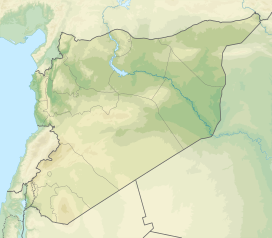Kurd Mountain: Difference between revisions
Undid revision 718614275 by 130.193.229.15 (talk) Disruptive editing |
No edit summary Tags: Mobile edit Mobile web edit |
||
| Line 48: | Line 48: | ||
[[Category:Geography of Turkish Kurdistan]] |
[[Category:Geography of Turkish Kurdistan]] |
||
[[Category:Rojava]] |
[[Category:Rojava]] |
||
[[Kategorie:Yazidi]] |
|||
{{-}} |
{{-}} |
||
Revision as of 22:45, 26 June 2016
| Kurd Mountains | |
|---|---|
| Kurd-Dagh | |
 Hills of the Kurd Mountains in Afrin | |
| Geography | |
| Location | Aleppo Governorate, Kilis Province |
Kurd Mountains or Kurd-Dagh (Template:Lang-ar Jabal al-Akrad; Kurdish: Çiyayê Kurmênc, چیای کورمنج; Turkish: Kürd Dağı), also called Aleppo Mountain (Template:Lang-ar Jabal Ḥalab), is a highland region in northwestern Syria and southeastern Turkey. It is located in the Aleppo Governorate of Syria and Kilis Province of Turkey. The Kurd mountain should not be confused with the neighboring Jabal al Akrad (Kurds' mountain) which is located further southwest towards the mediterranean coastline.
Location and description
Kurd Mountains are part of the Limestone Massif of northwestern Syria. The mountains are a southern continuation into the Aleppo plateau of the highlands on the western part of the Aintab plateau. The valley of River Afrin surrounds Kurd Mountains from east and south and separates it from the plain of Aʻzāz and Mount Simeon to the east, and from Mount Harim to the south. The valley of River Aswad separates Mount Kurd from Mount Amanus to the west.
In Syria, it is among the four "ethnic mountains" of western Syria, along with al-Ansariyah mountains ("Mountain of the Alawites"), Jabal Turkman ("Mountain of the Turkmen") and Jabal al-Duruz ("Mountain of the Druze").
The main town is Afrin (Efrîn in Kurdish), in Syria. The area is known for its olive growing and charcoal production. The majority of the Kurd-Dagh population are Hanafi-Muslims, while most Syrian Kurds are Shafiite-Muslims. Yazidis also have a presence in the region.[1]
Sherefname(1543 - 1599) asserts that the authority of Kurdish beys of the region was extended to localities in Antakya. In areas in the plains such as Islahiye, Kırıkhan, Reyhanlı, and Kilis, there are vestiges of Kurdish concentration in Kurd-Dagh. While other regions populated by Kurds in Syria faced an influx of Arab immigrants and the campaign of Arabization beginning in 1960s, Kurd-Dagh was spared from Arabization, mainly due to Syria's different policy based upon good relations with pro-Damascus landowners.
The Turkish part was renamed officially as Kurt Dağı ("Wolf Mountain"), with a pun on the Turkish words Kürd (Kurd) and kurt (wolf). In the Syrian part during the 1980s the Kurdish names of most of this region's villages were changed to Arabic as part of the process of Arabization.
References
- ^ Açikyildiz, Birgül (23 December 2014). The Yezidis: The History of a Community, Culture and Religion. London, UK: I.B. Tauris. p. 63. ISBN 1848852746.

